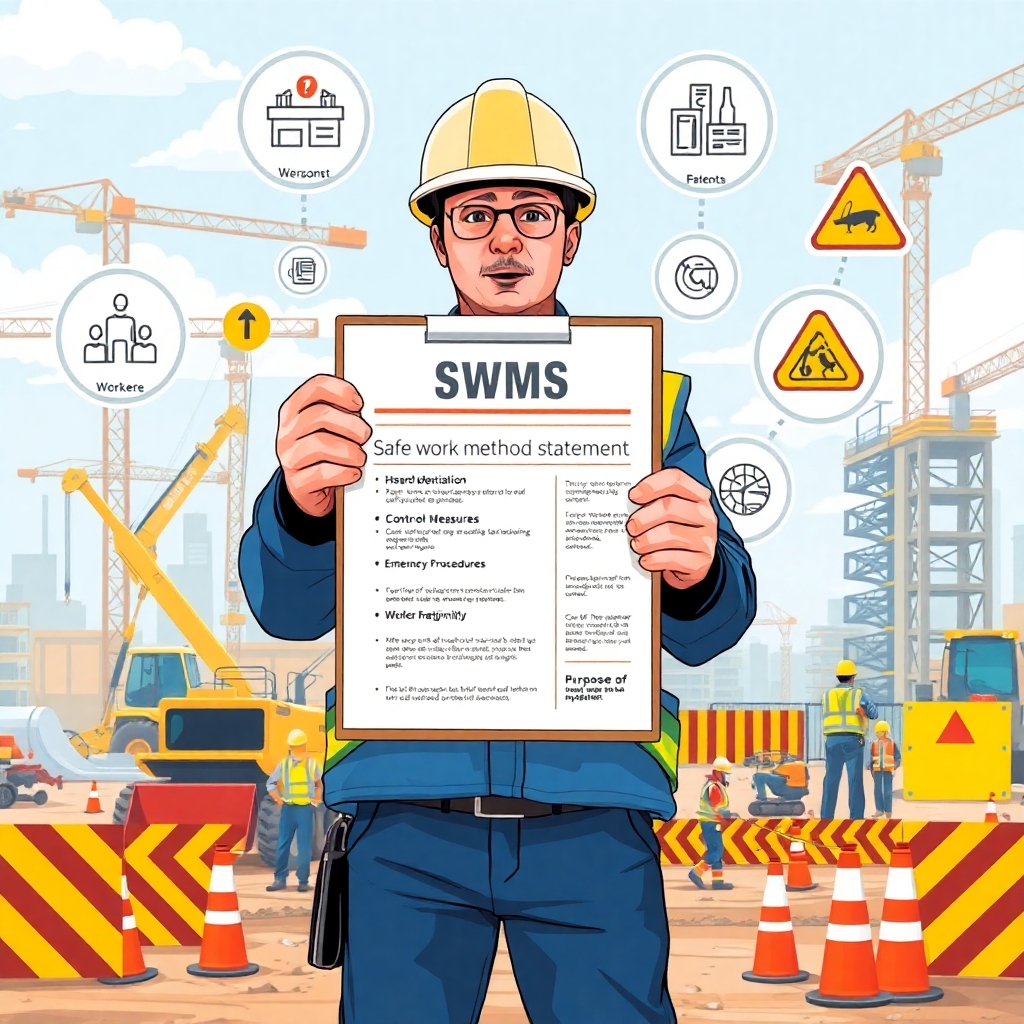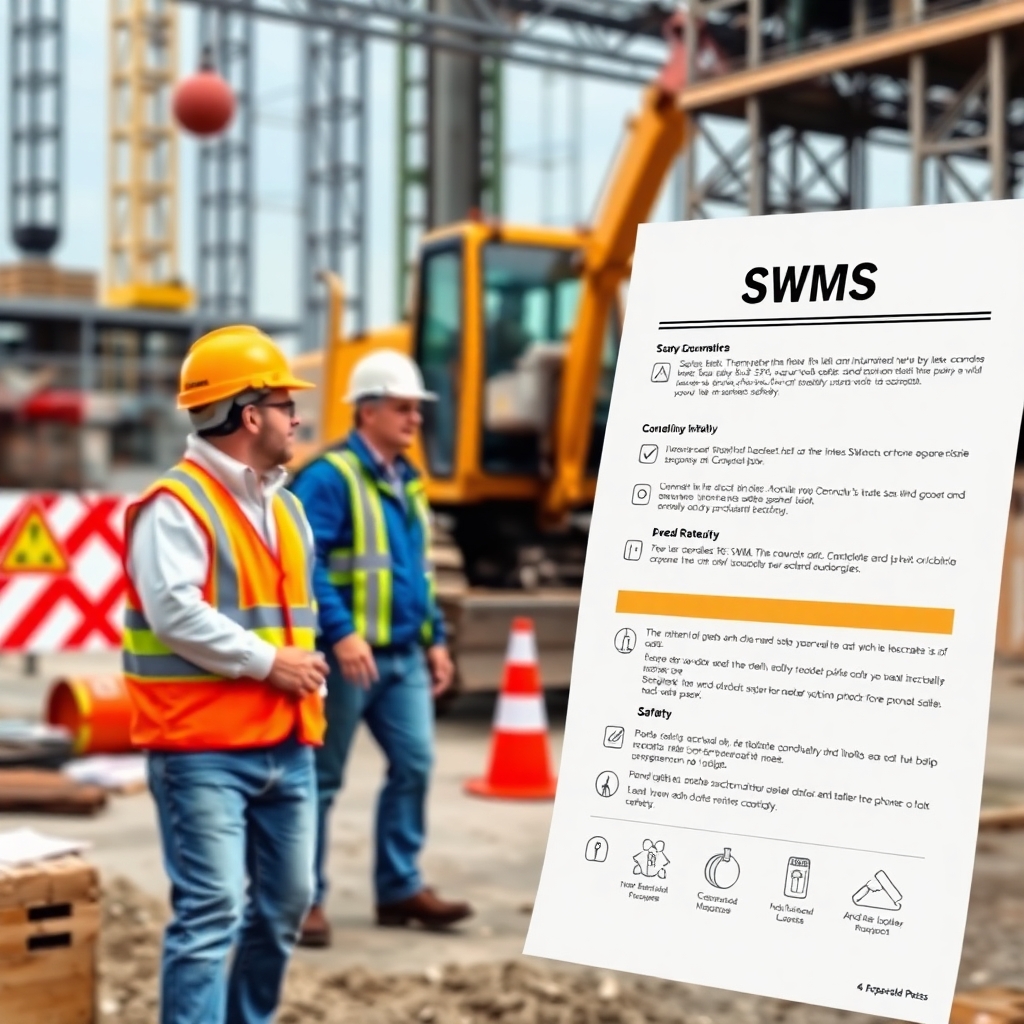What are SWMS?
A SWMS (pronounced ‘swims’ and often called ‘swims safety document’), or Safe Work Method Statement, is a document that outlines the specific safe work procedures for a particular task or activity. It is an important tool for construction workers and tradies because it helps to ensure that all employees are aware of the risks associated with a specific job and understand how to safely mitigate those risks in the workplace.
SWMS that have been properly written can make the difference between a job that runs smoothly and without incident and one that ends in disaster. Fortunately, there are numerous tools and resources available on our site that can assist you in learning more on what are swms, developing a safer and more effective SWMS for your next construction project.

SWMS Meaning & How to write a SWMS
The use of a template when writing your safe work method statement can make the process go more quickly and smoothly. A template is a document that has all the sections that will be needed in your work method statement.
One thing to keep in mind when writing your own safe work method statements is that a free swms template is only the bare minimum of what a safe work method statement should contain. It is your responsibility to complete the template with all of the tasks and other information required, whether you require it in order to get on a job site or because the law requires you to have a SWMS in place.
It is also necessary for the safe work method statement to be compliant with the current applicable work health and safety regulations in your state. A list of the information that needs to be included in a SWMS will be provided by the legislation; however, if you are using a free SWMS template, you may be missing out on some of this information. As a result, when writing your SWMS, make sure to research your state’s legislation, especially if you are using a free SWMS template.
With Safe-R Outcomes you can choose from a variety of safe work method statements that are more than just blank templates; all you have to do is fill in your company’s information and you are ready to distribute them.
For those who would prefer to use a free swms template and complete it themselves, we have compiled a list of the steps to take when writing your safe work method statement.
What are SWMS Safety Documents?
A Safe Work Method Statement (SWMS) is a document used to identify and control health and safety risks associated with high-risk construction work in Australia. It outlines the specific tasks being carried out, the hazards involved, and the measures put in place to eliminate or reduce those risks.
SWMS are primarily used on worksites to ensure everyone, from workers and supervisors to safety officers, understands how to perform the job safely. They are often read by principal contractors, site managers, safety consultants, and sometimes government inspectors.
In most cases, if you’re a subcontractor or tradesperson, you’ll be asked to provide a SWMS before starting work, especially by head contractors, local councils, or construction project managers. It’s not just a compliance form, it’s a communication tool that shows you’ve assessed the risks and have a plan to manage them.
What information should be included in a SWMS template?
The following is an example of a simple system for writing your swms:
1) The name of your company or the name of the individual who will be performing the work
2) Job site (e.g., cement silo, belt loader, start gate, etc.) or address (e.g., a building). If you work in a number of locations that are very similar to one another, it is generally acceptable to use a single safe work method statement for all of your jobs, with the location designation ‘various’.
3) What you will be doing (e.g. working at heights) – while most legislation only requires you to include high-risk construction work, industry experts recommend including any tasks that are completed that have the potential to injure a worker as part of your SWMS.
4) Hazards associated with the task (e.g. dust, noise, moving vehicles) – this one can sometimes be tough for people to include especially if they have been working in the industry for a while. Many construction workers and tradespeople are not aware of the dangers they are putting themselves in! In order to write your own safe work method statement, you will need to set aside some time to consider all of the hazards associated with each task you will perform during the course of your workday.
5) Control measures to be implemented in order to reduce or eliminate hazards (e.g., wearing a dust mask and using ear plugs)- some specific control measures, such as scaffolding, are required by law, while others, such as the wearing of safety boots, are simply expected to be implemented. You should be considering the ‘hierarchy of control‘ when deciding what control measures you will be using.
6) Any other employees who may be impacted by the project (e.g. those working next to the silo, those under a truck being filled with cement etc.)
8) The name of the worker who is completing the swms, as well as a method of demonstrating that you have communicated the contents of the safe work method statement to your employees. In most cases, this would be a sign-off sheet or an email with a time stamp attached.
Check out some of the common mistakes people make when writing a swms.

It is important to have a safe work method statement (swms) for any job that has the potential to cause harm, or as required by law in your state.
They should be tailored to the task or job in question, and they should include a list of the hazards associated with the task as well as a description of how they will be mitigated or eliminated. There’s some great examples of when a landscaping swms is required, and plenty of other industries that need a swms too.
It is also critical to ensure that the swms complies with the most recent applicable work health and safety regulations, which means that you cannot use a swms that was written five or ten years ago!
Furthermore, you must consider the type of workers you have on site; for example, do you have a large number of young workers who may require additional information and training, or do you have workers who speak English as a second language, in which case your safe work method statement must be as free of jargon as possible.
Following the completion of your SWMS, you must ensure that all employees have received a copy and have signed off on it, indicating that they have read and understood its contents. It is a good idea to keep a copy of the SWMS on site so that it can be accessed quickly. The majority of states’ legislation simply states that it must be easily accessible, but does not specify what that means in practical terms. Generally, you can have your SWMS in hard copy format or as a digital download.
When changes are made to the safe work method statement, or if new hazards are identified, you must update the SWMS and re-issue it to workers.
The steps outlined above will assist you in developing a safe and effective SWMS for your workplace.
Who Needs a SWMS?
Many trades need a swms and not having one can be costly, so it’s well worth having your swms in place.
Carpentry swms are commonly required due to the nature of the job, along with bricklaying swms which we have templates for. The best part is, with an online swms you can easily modify and keep track of your documentation.

How can Safe-R Outcomes help your business?
Our Professional subscriptions contain many essential documents including:
- WHS Management Plans / Safety Manuals
- SWMS (if the job entails high risk tasks)
- a range of SOPs, Registers, Toolbox Talks, Checklists and Policies
These can all be downloaded and are not blank templates, so can be used immediately.
We also provide Induction training to help you on-board new employees and contractors.
As you can see it is all done for you so it makes it nice and simple. You can find out more on the Industries and Professions page.
If you’re concerned about the time commitment and knowledge required to implement the correct documents, procedures and training for forklift safety, Safe-R Outcomes can help. We strive to reduce the time and cost for businesses to implement their legally necessary safety requirements.


